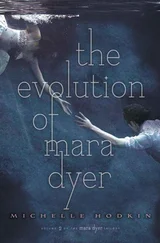I awoke the next morning to see three faces — those of Norman Plumlee, Prasad, and Lydia — scowling at me in disapproval. Well, the stoic faces of Plumlee and Prasad scowled in disapproval; they clearly did not like what I had done in the night to my cage furnishings — that is, destroy and scatter them — but on Lydia’s face was not what I would call a scowl so much as a distressed frown of sympathy. This is why, Gwen — this is why all great primatologists are women. The male human mind is hateful, bellicose, possessive, punitive, and jealous, obsessed with cold notions of law and property and justice. The male mind thinks: how dare — how dare you destroy and scatter the property we so kindly lent you, you insolent creature! The male mind ponders such pertinent moral questions as whose stupid acorns are these if I go to the trouble of bending over and picking them up? But the female mind is quicker to empathy than indignation, and that is one reason why Jane Goodall and Dian Fossey and Sue Savage-Rumbaugh and Lydia Littlemore made such great pioneers in primatology.
Norman Plumlee opened my cage door and I clambered gladly out, but was immediately met with many stern reproaches, and a castigatory hand with the thumb and bottom three fingers curled around the palm and the wagging index finger aimed at me. The hand belonged to Norman Plumlee. Norman grabbed a handful of the fluff and torn bits of fabric that my mat and fuzzy blanket had become in the night, and held them to my face and made “shame on you” noises.
“It’s okay — it’s okay,” said Lydia. She put on her glasses and immediately took them off again, and with both hands tucked two wisps of hair behind the ridges of her ears. “He’s probably in shock, Norm. He’s never spent a night away from home before. He just got a little freaked out last night.”
I was on the floor. I ran to Lydia and jerked on the leg of her pants and she picked me up and I hugged her and held on to her and planted my face against the soft flesh of her neck. I was forgiven.
I devoured some of the dehydrated food pellets that I had scattered the night before, not because they were at all palatable but because I had awoken with a belly roiling and snarling from hunger. I was permitted to play with my toys, but I did so only listlessly. The other humans arrived one by one with morning coffee steaming in their mugs. That day the experiments began in earnest. I remember how they presented me with flash cards with different symbols printed on them, and asked me, I think, to distinguish the cards from each other. I remember people making gestures at me, signs I was expected to attempt to emulate. I remember one particular experiment — all of these were repeated time after time and day after day, week upon week, I ought to remember them — in which I was shown an assortment of objects: stones, metal washers, pencils, plastic flowers, and small stuffed animals resembling pigs, chickens, rabbits, elephants, lizards, and the like (although they were not to scale — the elephant, for example, was the same size as the chicken). The human named Norm, the human who was clearly “in charge” here because all the other humans — even Lydia — seemed to defer authority to him, stored these artifacts in a big brown cardboard box that he removed from one of the cabinets under one of the long gray lab tables. He dumped the contents of the box onto the surface of the table and proceeded to sort them out for me, grouping the objects like with like: flowers with flowers, animals with animals, washers with washers, and stones with stones. Then, after sorting them, he would put all of the objects back in the box, shake it vigorously so as to randomly redistribute the contents and dump them back onto the table, then make a gesture indicating that I should sort them, like with like. If I sorted correctly, I was rewarded with a treat. If I sorted incorrectly, the treat was withheld.
I partook in these and other such experiments. They were fun, though sometimes I grew weary of them. Sometimes I was allowed to sit in the corner of the room on the squishy blue mat and manipulate my toys, and sometimes Lydia joined me. Oftentimes I crawled into her arms and looked into her bright brazen eyes and played with her bright blond hair. At lunchtime she put a collar on my neck and attached a leash (a degrading necessity in those early days), then picked me up and carried me through the building, down the stairs, and outside into the world, which was sunny but still soggy from yesterday’s rain. She brought her lunch with her in a brown paper bag. I was not particularly hungry because I had been plied with treats all morning for all the tasks I had correctly performed. She brought me to a courtyard behind the building that housed the Behavioral Biology Lab, a stretch of grass cut through with a brick path and surrounded by several buildings made of gray stone. There were many tall trees whose trunks were gray and knotted and gnarled like old men’s arms. Lydia sat down on a picnic bench and removed from the paper bag the following items: a turkey sandwich, diagonally bisected into two right triangles and wrapped in crinkly wax paper; a bottle of vitamin water; a green apple; and a “power” bar, which was a compact rectangular block of tightly compressed nutrients with raisins and chocolate chips embedded in it. She offered me a bite from each of these items, bites that I took more out of curiosity than hunger.
Since there was no one else around, Lydia unhooked my leash and allowed me to climb the trees, which I did, happily, in the sunlight, brachiating madly in their rustling canopies. Such an outrageous thrill it was to climb those giant trees, knowing that for the first time in my life there were no fences or walls or bars or windows to keep me inside. I could have easily run away if I’d wanted to, but of course I did not want to, not with Lydia beaming sweetly up at me from the picnic bench below, chewing on a wad of turkey sandwich held in her cheek. This being a university campus and this being the summer, there was very little foot traffic in the courtyard. The sun was bright and hot. I observed the midflight lovemaking of a pair of iridescent dragonflies.
Up and up and up I climbed into the canopy of the tallest and oldest and most magisterial tree in the courtyard. I scrambled into the highest branches that were still thick enough to support my weight. I emerged from the flapping green leaves to find myself standing higher than the highest of the buildings surrounding the grassy courtyard.
In every direction I saw a vast and strange and infinitely complex world previously unknown to me. I looked to the west, and saw the rooftops of buildings stretching endlessly into the distance, and far away a train shuffling along the elevated tracks and a highway with trucks lumbering along it and down the serpentine filigrees of overlapping exit ramps. I looked to the south, and saw the great vertical pipes of a hundred organs of industry unfurling satin scarves of black smoke into the air. I looked to the east, and saw a lapping and foaming body of blue-green water, speckled with sailboats and reaching out to the horizon where it became a thin band of silvery blue. And then I looked to the north.
I saw the stone titans of the downtown Loop looming high over Chicago. I did not yet know that each of these monsters had a name — the Tribune Tower, the John Hancock Center, the Sears Tower — but I knew that they shot into the sky so high that tracing their heights made me queasy and light-headed. I knew that they were designed with bizarre and terrifying features jagging and cragging out of them, juts and abutments and spikes and spurs and needles and bars and crowns and prongs and horns and forks and knives, a tangled skein of twisted metal appendages reaching up out of the earth like the fingers of enormous demons clawing their way out of hell to assault the heavens.
Читать дальше












